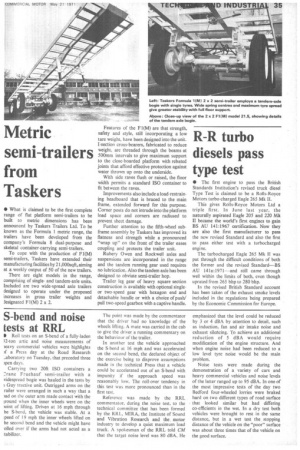S-bend and noise tests at RRL
Page 37

If you've noticed an error in this article please click here to report it so we can fix it.
ID Roll tests on an S-bend of a fully-laden 32-ton artic and noise measurements of -Leavy commercial vehicles were highlights )f a Press day at the Road Research _,aboratory on Tuesday, that preceded three )pen days.
Carrying two 2011 ISO containers a 2rane Fruehauf semi-trailer with a videspread bogie was hauled in the tests by
Guy tractive unit. Outrigged arms on the railer were arranged in such a way that a )ad on the outer arm made contact with the ;round when the inner wheels were on the vint of lifting. Driven at 16 mph through he S-bend, the vehicle was stable. At a ;peed of 19 mph the inner wheels lifted on he second bend and the vehicle might have .olled over if the arms had not acted as a tabilizer.
The point was made by the commentator that the driver had no knowledge of the wheels lifting. A mate was carried in the cab to give the driver a running commentary on the behaviour of the trailer.
In another test the vehicle approached the S-bend at 16 mph and was accelerated on the second bend, the declared object of the exercise being to disprove assumptions made in the technical Press• that a vehicle could be accelerated out of an S-bend with impunity if the approach speed was reasonably low. The roll-over tendency in this test was more pronounced than in the first test.
Reference was made by the RRL commentator, during the noise test, to the technical committee that has been formed by the RRL, MIRA, the Institute of Sound and Vibration Research and the, motor industry to develop a quiet maximum load truck. A spokesman of the RRL told CM that the target noise level was 80 dBA. He emphasized that the level could be reduced by 3 or 4 dBA by attention to detail, such as induction, fan and air intake noise and exhaust silencing. To achieve an additional reduction of 5 dBA would require modification of the engine structure. And when engine noise had been reduced to a low level tyre noise would be the main problem.
Noise tests were made during the demonstration of a variety of cars and heavy commercial vehicles and noise levels of the latter ranged up to 95 dBA. In one of the most impressive tests of the day two Bedford four-wheeled lorries were braked hard on two different types of road surfa.ce that looked similar but had differing coefficients in the wet. In a dry test both vehicles were brought to rest in the same distance, but in a wet test the stopping distance of the vehicle on the "poor" surface was about three times that of the vehicle on the good surface.






























































































































